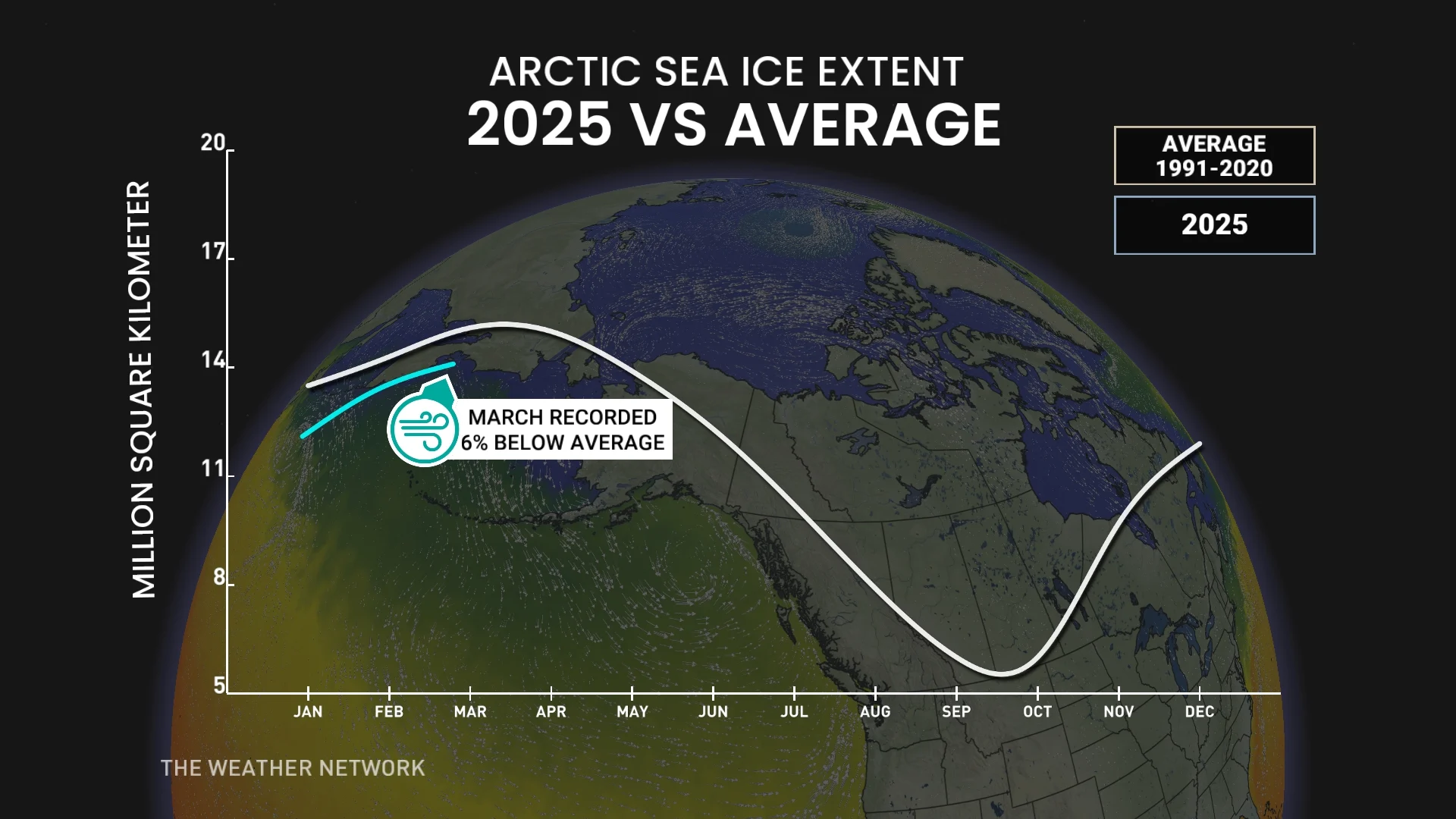
Earth nears heat record as Arctic sea ice hits historic March low
March 2025 was another month of concern for the globe, with the second-warmest March ever documented while Arctic sea ice hit a new, record low. The correlation between the two is critical as sea ice plays a crucial role in reflecting sunlight and regulating the planet's temperature.
Global temperatures continue to rise and approach new benchmarks amid an alarming trend in recent years.
Last month was the second-warmest March globally, with an average ERA5 surface air temperature of 14.06 C. The reading was 0.65 C above the 1991-2020 average and 1.60 C above the pre-industrial level for March, according to the European Union's Copernicus Climate Change Service (C3S) report, which was released on Monday night.
SEE ALSO: Why the Arctic's accelerated warming is an alarm bell for the planet
In addition to those concerning statistics, the Arctic sea ice reached its lowest, monthly extent for March in a 47-year satellite record, registering at six per cent below average, according to C3S. The figure earmarks the fourth successive month that the level of sea ice has hit a record low for this time of the year.

Anomalies in surface air temperature and precipitation for March 2025 with respect to March averages for the period 1991-2020. The precipitation anomalies correspond to the total precipitation for the month expressed as a percentage of the average for 1991-2020. Data source: ERA5. (C3S/ECMWF.
While last month was the second-warmest worldwide, it was Europe's hottest on record. The average temperature in Europe last month was 6.03 C ––2.41 C above the 1991-2020 median for March–– making it the continent's warmest ever.
"March 2025 was the warmest March for Europe, highlighting once again how temperatures are continuing to break records. It was also a month with contrasting rainfall extremes across Europe with many areas experiencing their driest March on record, and others their wettest March on record for at least the past 47 years," said Samantha Burgess, strategic lead for climate at the European Centre for Medium-Range Weather Forecasts (ECMWF), in a news release.
Temperatures slightly cooler than record 2024 March
C3S said March 2025 was just 0.08 C cooler than the record March of 2024, and only a tad warmer--by 0.02 C--than the third-warmest March (2016).
The report also pointed out that March was the 20th month in the last 21 months in which the global-average surface air temperature exceeded 1.5°C above the pre-industrial level. As well, April 2024 to March 2025's median was 0.71 C above the 1991-2020 average, and 1.59 C beyond the pre-industrial level.

Monthly, global surface air temperature anomalies (C) relative to 1850–1900 from January 1940 to March 2025, plotted as time series for each year. The year 2025 is shown with a dark red line, 2024 with a dark orange line, 2023 with a yellow line, and 2016 with a light orange line. All other years are shown with thin grey lines. Data source: ERA5. (Copernicus Climate Change Service /ECMWF).
For the most part, Europe as a whole experienced hotter-than-usual temperatures. The largest, warm anomalies recorded over eastern sections and southwest Russia, according to C3S. However, the Iberian Peninsula was an exception, with colder-than-average temperatures recorded.
It wasn't just Europe that experienced above-normal temperatures. Values last month were most above average in large parts of the Arctic region, particularly over the Canadian Archipelago and Baffin Bay. As well, they were above normal in the United States, Mexico, parts of Asia and Australia.
SEE ALSO: Canada makes major announcement at COP29
New March record low for Arctic sea ice

The decline of Arctic sea ice has been well documented in recent years.
In March 2025, another new benchmark was reached. At six per cent below average, Arctic sea ice hit its lowest, monthly extent for March in a 47-year satellite record. March was the fourth consecutive month in which the sea ice level has established a record low for this time of year.
And when the sea ice in the Arctic peaked last month, March also marked its lowest, annual maximum ever recorded in the region.
C3S found sea ice concentrations were most below normal outside the central Arctic Ocean, especially in the Barents Sea and Sea of Okhotsk.

As well, Antarctic sea ice recorded its fourth-lowest, monthly extent in March––a staggering 24 per cent below average, according to the report.
In the Antarctic region, sea ice concentrations were below average in most ocean sectors, with the exception of the western Weddell Sea.
In line with the above-normal temperatures in March, the sea surface temperatures were also quite warm––a trend that's been ongoing for some time. The average sea surface temperature (SST) for March 2025, in locales situated at 60 South–60 North was 20.96 C, the second-highest reading on record for the month, but remained 0.12 C below the March 2024 record.
Also, SSTs remained abnormally high in numerous ocean basins and seas, C3S said. The Mediterranean Sea and parts of the North Atlantic were among multiple seas that observed larger, record-breaking areas than last month.
WATCH: NOAA's 2024 Arctic Report Card
Thumbnail courtesy of Getty Images/leolintang/2154948176-170667a.

